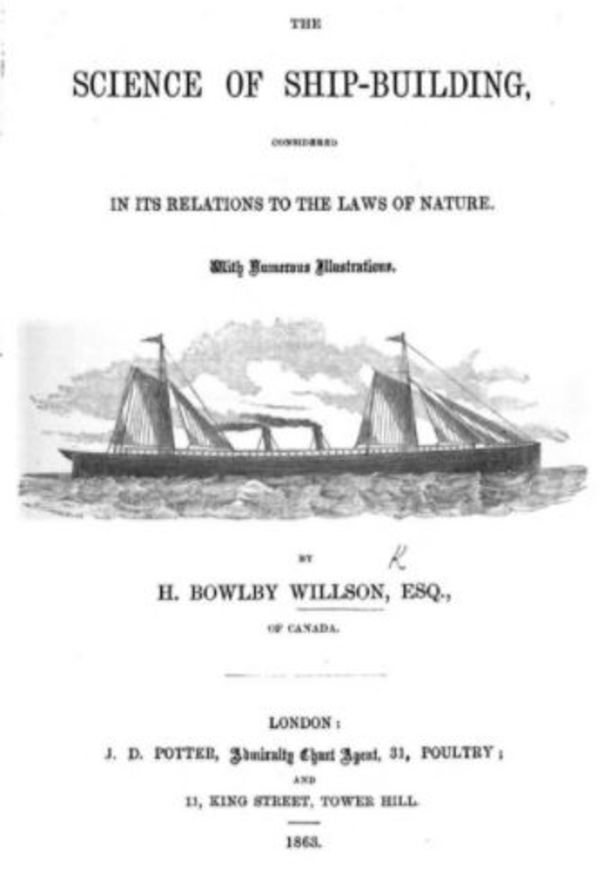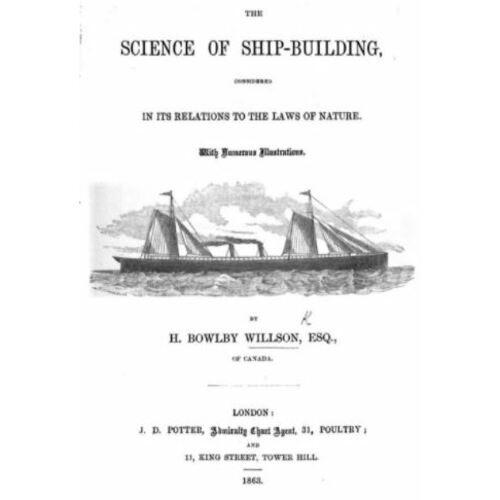
Source: Link
WILLSON, HUGH BOWLBY (Bowlsby, Boultby), barrister, author, journalist, and businessman; b. in Saltfleet Township, U.C., 15 Sept. 1813, third son of John Willson* and Elizabeth Bowlby, and uncle of Thomas Leopold “Carbide” Willson*; d. in New York City, 29 April 1880.
Hugh Bowlby Willson was educated at the Gore District grammar school in Hamilton and became a close friend of John Rae, headmaster of the school. From Rae and from his own father Willson received his interest in the economic ideas of Adam Smith. Politically, Willson became first a Peelite Conservative and signed with Rae a petition in January 1836 calling for a public display of loyalty to the king in opposition to the Upper Canadian Reformers. He served in the rebellion in 1837 as a lieutenant in the 3rd Regiment of Gore militia. In the 1840s, though acquainted with such Reformers as Hamilton Hartley Killaly, William Hamilton Merritt*, and Francis Hincks*, he distrusted the Reform leadership of Robert Baldwin*. Instead, he considered himself independent of party and favoured policies for the promoting of economic development of the united province.
For a short time in 1834 Willson had been a purser on a steamer on Lake Ontario. In 1836 he began to study law and was admitted to the bar in 1841, but before practising he travelled to the West Indies for his health. He spent some time in Trinidad and wrote articles about its “natural curiosities” in the New York Albion.
Willson apparently had limited success as a barrister. He turned to land speculation in the late 1840s and to development of real estate in the Hamilton region, laying out a residential area in east Hamilton and villa lots in the village of Ontario (later named Winona). In 1847 he was secretary of the Upper Canada Mining Company. His attention also turned to journalism. He was always keenly interested in topical affairs and contributed articles to the Hamilton Spectator for many years after its establishment in 1846.
When the British parliament abandoned mercantilism in the late 1840s, Canada lost its preferred trading position and suffered a serious recession; many disgruntled merchants and politicians began to consider an alternative economic alignment to benefit the colony, annexation to the United States. To discuss the new problems facing Canada, the British American League was formed in 1849, largely by Tories. When it met at Kingston in July under the presidency of George Moffatt*, Willson was a delegate for Saltfleet Township. He spoke in favour of annexation, and withdrew from the league in September because it rejected the idea. In succeeding months he followed Luther Hamilton Holton and Alexander Tilloch Galt* in advocating Canadian separation from the British Empire and annexation to the United States, and in October 1849 he founded and edited the annexationist Independent, a Toronto weekly; Willson lost a considerable amount of money when it failed in April 1850 from lack of interest and financial support. That year he was a secretary of the Toronto branch of the annexation committee.
Willson abandoned his law practice about 1852 and became a dealer in securities in London, England, with William Shaw and Malcolm Cowan. While in England he may also have written for the London Times. He was appointed a commissioner to the Paris Exposition of 1855 by the Canadian government; he was again in Hamilton in that same year, and by 1857 appears to have settled there. He became the first editor of the Hamilton Times in 1858, resigning in 1860. It was an independent liberal paper, which succeeded the Hamilton Banner and strongly promoted the commercial development of Canada. Willson also wrote widely on currency and banking, and on the advantages of a written constitution for Canada, An early advocate of building the Great Western Railway, he canvassed for municipal subscriptions to the company’s stock. He was also active in planning the construction of the Hamilton and Port Dover Railway (later called the Hamilton and Lake Erie).
In the early 1860s Willson resided in Quebec City as parliamentary correspondent for the Quebec Morning Chronicle and other newspapers; for the Chronicle he wrote a series of articles on Canada’s defence problems which were subsequently published as a pamphlet in 1862. As a resident of Quebec City, in 1864 he described himself: “Barrister and Attorney at Law, parliamentary agent, solicitor of patents of invention, &c. &c.”
Willson moved to Washington, D.C., around the close of the Civil War and married Harriot Conway Ladde of that city. He later settled in New York City but continued to follow Canadian affairs and to write for the Hamilton Spectator. He had sophisticated and advanced ideas on monetary theory, and was a persistent advocate of reform of the money and banking system in both the United States and Great Britain. He became deeply involved in the postwar “Greenback” controversy in the United States. In a number of pamphlets and in testimony before a congressional committee in 1879, he argued strongly that notes issued by the state should be the permanent and exclusive circulating medium. He suggested the creation of a currency board to control the issue of paper money and proposed that the amount of paper money should be related to the volume of business transactions in the country. He believed that monetary mismanagement was a principal cause of periodic depressions in Great Britain and the United States. He was also a vigorous opponent of the Bank of England and wanted the introduction of one pound notes for general circulation “of a convenient size for pocket use.”
The quality of Willson’s writings on money and banking was excellent and he foreshadowed a number of welcome changes which were to be introduced after his death. He kept in touch with his friend and mentor John Rae until Rae’s death in 1871, and, although he does not specifically refer to Rae in his writings, he was clearly influenced by his penetrating ideas on economics. He died in New York in 1880, survived by his wife and two adopted children.
H. B. Willson is the author of: Canada and the United States: [a letter] to the editor of the National Intelligencer (Washington, 1849); Currency; or, the fundamental principles of monetary science postulated, explained and applied (New York, 1882); Great Western Railway of Canada (Hamilton, Ont., 1860); The Great Western Railway of Canada: its proposed branches and extensions (London, 1854); High speed steamers; or, how to build a river boat to run thirty miles an hour (Albany, N.Y., 1866); Industrial crises, their causes and remedies . . . from the report of the congressional committee on depression in labour and business (Washington, 1879); The military defences of Canada, considered in respect to our colonial relations with Great Britain, in a series of letters published in the Quebec “Morning Chronicle” (Quebec, 1862); The money question considered scientifically and practically .. . (London, 1874); A plea for Uncle Sam’s money: or greenbacks versus bank notes (New York, 1870); The proposed Hamilton and South-western Railway (Hamilton, Ont., 1854); Reports and correspondence on the “Patent Compound Rail” (London, 1851); The science of money considered . . . (Washington, 1869); The science of ship-building, considered in its relations to the laws of nature (London, 1863).
Hamilton Public Library (Hamilton), Land papers, 1838, p.34; 1849, p.6; 1850, p.3. New York County, Surrogate’s Court (New York), will of Harriot C. Willson. PAO, William Hamilton Merritt papers, H. B. Willson to W. H. Merritt, 17 Dec. 1842, 2 April 1859. “The annexation movement, 1849–50,” ed. A. G. Penny, CHR, V (1924), 236–61. [Bruce and Grey], Elgin-Grey papers (Doughty), I, 446. Hamilton Spectator, 1, 4, 5 May 1880. Montreal Gazette, 19 Jan. 1836. Canada directory . . . 1851, ed. R. W. S. Mackay (Montreal, 1851), 108. A supplement to the Canada directory . . . 1853, ed. R. W. S. Mackay (Montreal, 1853). Arthur papers (Sanderson). C. D. W. Goodwin, Canadian economic thought: the political economy of a developing nation, 1814–1914 (Durham, N.C., and London, 1961). Middleton, Municipality of Toronto, I, 241. C. D. Allin, “The British North American League, 1849,” Ont. Hist., XIII (1915), 74–115. Annals of the Forty (Grimsby), IX (1958), 66. Canadian Library Association, Microfilm committee, News Notes (Ottawa), September 1959.
Cite This Article
R. Warren James and John S. Moir, “WILLSON, HUGH BOWLBY (Bowlsby, Boultby),” in Dictionary of Canadian Biography, vol. 10, University of Toronto/Université Laval, 2003–, accessed January 17, 2026, https://www.biographi.ca/en/bio/willson_hugh_bowlby_10E.html.
The citation above shows the format for footnotes and endnotes according to the Chicago manual of style (16th edition). Information to be used in other citation formats:
| Permalink: | https://www.biographi.ca/en/bio/willson_hugh_bowlby_10E.html |
| Author of Article: | R. Warren James and John S. Moir |
| Title of Article: | WILLSON, HUGH BOWLBY (Bowlsby, Boultby) |
| Publication Name: | Dictionary of Canadian Biography, vol. 10 |
| Publisher: | University of Toronto/Université Laval |
| Year of publication: | 1972 |
| Year of revision: | 1972 |
| Access Date: | January 17, 2026 |



